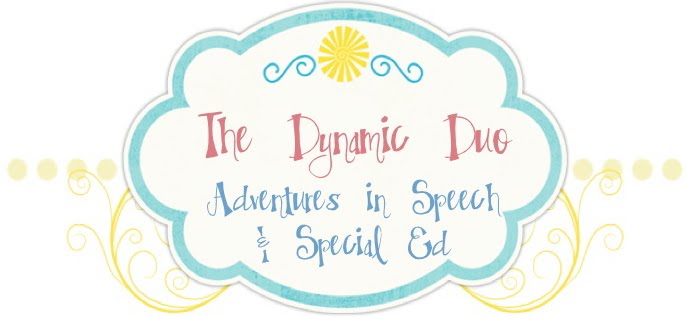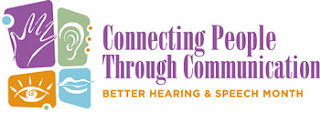In honor of Better Speech and Hearing Month, we thought we would kick of May with a success story from our collaboration through speech therapy and special education services.
The story begins with a kindergarten boy . . . This young boy melted our hearts the moment we laid eyes on him, an adorable and huggable little guy. He came to us as a kindergartener after his previous educational team had deemed it necessary for him to have a second round of kindergarten. During his previous year in school, he was evaluated and found to have a speech and language impairment and had begun receiving speech therapy earlier that spring.
It didn't take long for us to realize that this child's challenges far exceeded that which could be provided by traditional speech therapy services alone. In addition to his deficits in articulation and language, he struggled with listening/attending skills, social/behavioral skills, and academic skills. As his SLP and case manager at the time, I had to work closely and diligently with his teacher and the campus staff to collect sufficient data needed in order to provide additional services. Thanks to an amazing campus and administration, we were able to begin providing him with additional inclusion and resource supports through our Social Communication Resources and Services Program while he was being evaluated for an additional disability.
As we began developing a program for this student, Kelley and I worked collaboratively to develop social stories in order to teach him school rules and routines. Kelley also worked diligently with the classroom teacher to develop positive behavior supports and teach behavior expectations through the use of discrete trial techniques. These same techniques were also used during his small group pull-out sessions in speech therapy and in the areas of reading and writing. Kelley and I also included this student in a co-taught Social Thinking group and started directly teaching social thinking skills such as Whole Body Listening and Expected and Unexpected Behaviors. We, along with his teacher and administrators, worked diligently through months of tantrums and tears with this child. As he came to the end of his kindergarten year, we saw significant changes in his behavior and attention.
Also in the midst of chipping away at this students behavioral challenges, we used collaborative efforts and techniques to make changes to his speech, language, and academic skills. In speech therapy, I focused primarily on his motor speech deficit in a small group with 1-2 other students. It wasn't long before Kelley inquired about how this was being accomplished and she quickly was on board with trying out a new program to work on his reading skills. Together, we used various aspects of the Lindamood Phoneme Sequencing Program for Reading, Spelling, and Speech or LiPS Program.
This program, developed by Lindamood Bell, has a great series of visuals and techniques for developing all skills related to speech, reading and spelling. From a motor-speech aspect, I have used the Mouth Pictures and corresponding Phoneme cues to teach articulation skills. The cues are very descriptive and easy for students of all ages to understand.
Using these cues in speech therapy and then transitioning the same cues into this child's resource classroom really seemed to bridge the gap for him as he learned to identify and name letters and sounds and then sequence these sounds with appropriate coordination for speaking and reading. Using a multi-sensory and collaborative approach for this child significantly contributed to his progress in speech, language, reading, and writing. This type of program is inherently designed to help coordinate the development of all three of these skills. I highly encourage SLPs and teachers to coordinate their efforts and combine their expertise regarding motor-speech and oral language development with developing reading and writing skills.
Thanks to a great TEAM approach, this child is now at the end of his first grade year speaking with much greater intelligibility of speech, reading independently on grade level, and writing on grade level with minimal accommodations and daily supports. He remains in speech therapy to support continued increases in intelligibility of speech, particularly in the area of sequencing complex co-articulation as well as improving expressive syntax to age appropriate levels. But overall, this student's success is clearly the result of a collaborative approach.
~Orlanda




Thanks for sharing! Thank you also for spreading the word about BHSM!
ReplyDeleteHi Orlanda,
ReplyDeleteI used this program to teach my moderately mentally impaired/Autistic/Bipolar son to read. I followed the program pretty closely. My youngest child has the same issues. I have modified the program for her because she was unable to learn the material at the pace Lindamood Bell recommends. I do the "noisy sounds" first and introduce new noisy sounds slowly. Right now, we have done b, d, g, j, i, o. I am adding v today. Then I am going to add the soft sound that goes with the noisy sound. She is past identifying beginning sounds. So, I have her sort pictures by ending sounds. If she has trouble distinguishing between a hard and soft sound at the end of a word, my plan is to sort pictures by the beginning sound. (I did this when she confused j/g at the end of a word and it seemed to work well). Does this sound like a sound plan to you? WE also do tracking with mouth pictures and blocks. She is able to do VC words and is getting much better at spelling CVC words. She can identify changes to the consonants in the words, is inconsistent with the vowels.
I have taught many people to read with this program, but no one who has had so many problems. I refuse to believe she can't learn to read. They said my son wouldn't learn and he has!
I have made her games to help her practice sorting pictures by their ending sounds and also worksheets. I have file folder games and I have also made board games, dominoes, and centers for her. Can you suggest anything else? Heather Rice
web page - specialedbootcamp.com